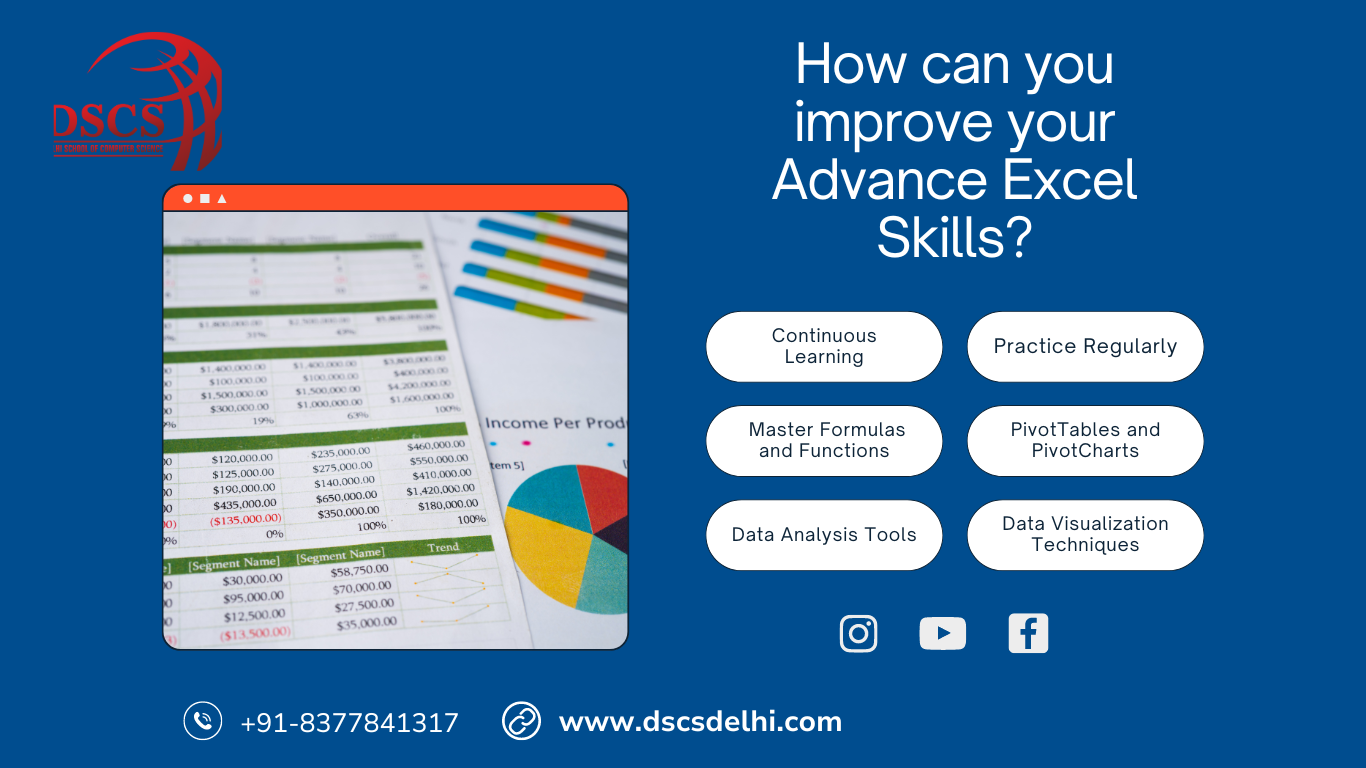
Microsoft Excel is a powerful tool used by professionals across various industries for data analysis, reporting, and visualization. While many individuals have basic proficiency in Excel, mastering advanced techniques can significantly enhance productivity and efficiency. In this guide, we’ll explore strategies to improve your advanced Excel skills, covering topics such as data manipulation, formulas and functions, data visualization, automation, and more.
Excel is a vast software with numerous features and functionalities. Engaging in continuous learning is crucial for mastering advanced skills. Utilize online resources such as tutorials, blogs, and YouTube channels dedicated to Excel. Additionally, consider enrolling in structured courses or certifications offered by platforms like Coursera, LinkedIn Learning, or Udemy. These resources provide structured learning paths covering advanced topics in Excel.
The adage “practice makes perfect” holds true for Excel proficiency. Regularly challenge yourself with complex tasks and datasets to reinforce your skills. Set aside time each week to work on Excel projects, whether it’s analyzing financial data, creating interactive dashboards, or performing statistical analysis. The more you practice, the more confident and adept you’ll become in utilizing advanced Excel features.
Formulas and functions are the backbone of Excel’s functionality. To enhance your proficiency, familiarize yourself with advanced formulas such as INDEX/MATCH, SUMIFS, COUNTIFS, and VLOOKUP. Additionally, explore array formulas, which enable you to perform complex calculations on multiple cells simultaneously. Understanding these functions and when to apply them is essential for efficient data analysis and manipulation.
PivotTables and PivotCharts are powerful tools for summarizing and visualizing large datasets. Learn to create PivotTables to analyze data dynamically and generate insights quickly. Experiment with different layouts, filters, and calculated fields to customize your PivotTable reports. Similarly, master PivotCharts to create dynamic visual representations of your data, allowing for easier interpretation and analysis.
Excel offers a range of built-in data analysis tools that can streamline complex analytical tasks. Explore features such as Goal Seek, Solver, and Data Tables for scenario analysis and optimization. Familiarize yourself with the Analysis ToolPak add-in, which provides advanced statistical functions for regression analysis, correlation, and histogram generation. Integrating these tools into your workflow can expedite decision-making and problem-solving processes.
Effective data visualization is essential for communicating insights and trends clearly. Experiment with Excel’s charting capabilities to create visually appealing and informative charts and graphs. Learn to customize chart elements such as axes, titles, labels, and legends to enhance clarity and readability. Explore advanced chart types like waterfall charts, heatmaps, and sparklines to convey complex information concisely.
Excel’s macro recording feature and Visual Basic for Applications (VBA) enable automation and customization of repetitive tasks. Invest time in learning VBA programming to create macros that automate complex processes, increase efficiency, and improve accuracy. By mastering VBA, you can develop custom solutions tailored to your specific needs, ranging from automated reporting to interactive user interfaces.
Excel offers various collaboration features that facilitate teamwork and sharing of workbooks. Explore options such as co-authoring, comments, and version history to collaborate seamlessly with colleagues on shared projects. Utilize OneDrive or SharePoint for cloud-based storage and real-time collaboration, ensuring everyone is working with the latest data and updates.
Microsoft regularly updates Excel with new features and enhancements. Stay informed about these updates by following official Microsoft announcements and release notes. Experiment with new features as they become available to stay ahead of the curve and leverage the latest tools and functionalities to streamline your workflow.
Engage with Excel communities and forums to exchange ideas, seek advice, and learn from experienced professionals. Platforms like Stack Overflow, Reddit’s r/excel community, and LinkedIn groups dedicated to Excel offer valuable insights, tips, and solutions to common challenges. Participating in these communities can broaden your knowledge base and provide opportunities for networking and collaboration.
In conclusion
Mastering advanced Excel skills requires dedication, practice, and a willingness to explore new techniques and features. By continuously learning, practicing regularly, and leveraging advanced functionalities, you can enhance your productivity, efficiency, and effectiveness in utilizing Excel as a powerful tool for data analysis and decision-making.
To enroll in DSCS Institute Advance Excel course in Laxmi Nagar, visit their website or contact them directly.
A-118, 2nd Floor, Metro Pillar No.35, Main Vikas Marg, Opp. Raymond Showroom, Laxmi Nagar, Shakarpur, New Delhi, Delhi 110092
08:00 AM to 08:00 PM
M : +91-8377841317



Don’t miss our future updates! Get Subscribed Today!
©2023 All Rights Reserved.